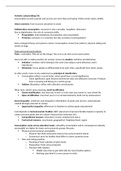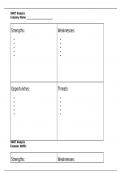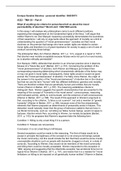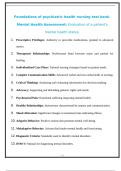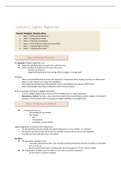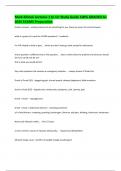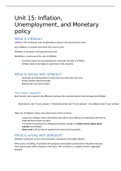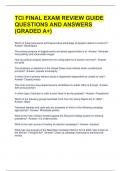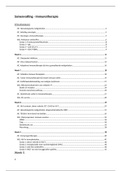Lecture 1 – cellular level 1
Input accumulates in the body of the neuron, until it reaches a certain threshold neuron fires?
biology more complicated
There are a lot of different cell types and different neuron types.
Kandal chapter 7
Electrical signals that carry time-sensitive information rapidly over long distances (e.g. receptor
potentials, synaptic potentials, action potentials) current flow changes that drive electrical
potential across the cell membrane away from its resting value
Fluctuation of the potential acts as signalling mechanism that permits nerves to interact, muscles to
contract and communication to occur over the whole body
Two types of ion-channels:
Resting
o Open and not influenced significantly by extrinsic factors (such as potential across
membrane)
o Maintaining the resting membrane potential
Gated
o Closed when at rest
o Open with changes in membrane potential, ligand binding or membrane stretch
Membrane potential: charge separation gives rise to difference of electrical potential over the
membrane
Membrane potential (Vm) = Vin-Vout
Direction of current flow is conventionally defined as the direction of net movement of positive
charge
Separation of charges across cell membrane of positive and negative ions:
At rest: excess of positive charges on outside of membrane and excess of negative charges
on inside
o Maintained because of lipid bilayer
o In rest the membrane potential is called the resting membrane potential
o Vout defined as zero Vr = Vin -60 mV to -70 mV
Depolarization: reduction of charge separation less negative charge
Hyperpolarization: increase in charge separation more negative membrane potential
Electrotonic potentials: changes in the membrane potential that do not lead to the opening
of gated ion channels often hyperpolarisation or small depolarization
When depolarization reaches threshold action potential
Resting membrane potential determined by resting ion channels:
Na+ and Cl- are more concentrated on outside and K+ and organic anions (A-) on inside
Resting channels in Glial cells are selective for potassium (K+) only
o K+ in high concentration on inside (also A-) tend to diffuse to outside positive
charge on outside, negative inside potential difference tends to oppose the
further efflux of K+
o Ions subject to two forces:
Chemical driving force depends on concentration gradient across membrane
1
, Electrical driving force that depends on the electrical potential difference
across the membrane
o When the chemical force (drives K+ out of cell) = electrical force (drives K+ into cell)
potassium equilibrium potential, Ek in this cell also the resting membrane
potential because the membrane is only permeable to K+
Resting channels in nerve cells are selective for several ion species
o Permeable for Na+, Cl- and K+
o Ion flux = (electrical driving force + chemical driving force) x membrane conductance
o If the driving forces are high, but not that much ion channels for that ion, still a low
influx
At a small patch of the membrane:
so current depends on chemical driving force (concentrations)
and electrical driving force (electrical potential difference)
E = electric field, sigma = conductance = g in lecture 1, u = mobility (how fast can they go)
depends on temperature (measure for mean kinetic energy),
mobility and the difference in concentration
Equilibrium = diffusion current + electric current = 0
Nernst equation/Nernst potential (for only 1 ion): Vin-Vout = Vm
(resting membrane potential ion x; Vin-Vout), R = gas constant, T temperature in degrees Kelvin, z
valence of ion, F faraday constant. And concentrations outside and inside cell.
Or 58 mV / z log [ion]o/[ion]I since RT/F = 25 mV at 25 degrees and ln to log is 2.3
Single cell electrophysiology:
Electrical activity of nerve cells and muscle fibres is completely determined by the properties
of the cell membrane
Ion currents with more than one ion
U = mobility = mechanical, conductance is an electrical
reduces to Nernst equation for that iion when permeability to one ion is exceptionally high at
peak of action potential to Nernst of Na+
resting (reversal) potential if you fill in the equation = -70 mV
na+/k+ balance is kept constant by pumps energy necessary
Applies only when the Vm = not changing.
U for membrane at rest: 1.0:0.04:0.45 for K, Na and Cl respectively
But at peak of action potential: 1.0:20:0.45, so peak determined by Na
Na/K-ATPase and Calcium ATPase most important energy consumers cell passive flux balanced by
active pumping of the ions by ion pumps 3 Na out, 2 K in net outward ionic current
2
,electrogenic hyperpolarize the membrane to somewhat more negative potential than would be
achieved with the passive-diffusion mechanisms discussed above.
Cl-, not taken into account, valid for neurons with no active pump, so mostly in its equilibrium.
Other neurons have a pump for Cl- use not ATP but energy stored in a pre-existing ionic
concentration gradient for different type of ion secondary active transport.
Effect of increasing Cl- gradient is to make the equilibrium potential for Cl- ions more negative than
the resting membrane potential overall.
Permeability: only depends on types and numbers of ion channels in Goldman equation
Conductance: measures the ability of the membrane to carry electrical current. Not only depends on
properties of the membrane but also on the concentration of ions in solution in electrical
measurements and equivalent circuits
gK = conductance of all K channels = equal to the number of resting K channels x conductance of an
individual K channel
Equivalent circuit:
Conductors or resistors ion channels
Batteries concentration gradients of relevant ions
Capacitors ability of membrane to store charge
Input resistance determines the magnitude of passive changes in membrane potential
Neurons have three passive electrical properties that are important to electrical signalling: the
resting membrane resistance, membrane capacitance and the intracellular axial resistance along
axons and dendrites.
B: injecting negative charge to membrane negative membrane potential hyperpolarized
linear relation between size of negative current and steady state hyperpolarization relation
between current and voltage defines a resistance Rin, the neuron’s input resistance
Same with positive charge depolarization, but only over limited voltage range large enough
current will produce a depolarization that exceeds threshold action potential no simple
resistance anymore
The input resistance determines how much the cell will depolarize in response to a steady current.
Thus two neurons receiving identical synaptic current input, the cell with the higher input resistance
will show a greater change in membrane voltage.
Rin = Rm (resistance membrane) / 4pia^2, a=radius neuron
A: Changing the current lead to the response of the membrane potential exponential up when
current is increased but levels off because of membrane acting as resistor (owing t oion-
conduction channels) and capacitor (owing to phospholipid bilayer) in parallel; with only resistive
3
, instant change with step change in current; with only capacitor linear change, therefore the relation
seen above decreases when current is decreased again.
Membrane voltage increases more slowly than the stepwise current increase, due to the
capacitance. Voltage across capacitance is proportional to the charge stored on the capacitor (V = Q/
C Q is charge in coulomb, C is capacitance in farads). dV = Ic x dt /C. The larger the area of a
capacitor, the more charge it will store for a given potential difference. Also dependend on insulation
medium and distance between the two plates. Cin = Cm(4pia^2)
Ionic membrane current: resistive current carried by ions flowing across the membrane through Na+
channels
Capacitive membrane current: current carried by ions that change the net charge stored on the
membrane only when Vm Is changing
Total current crossing membrane Im = Iionic + Icapacitive
First only current through capacitor become more positive rapidly increase in Vm more
resistive current increase levels off until current through capacitor is almost 0 see figure above
A. dVm (t) = ImRm (1-e^-t/tau). Tau = RinCin
resistance (Gna and Gk) is
dependent on the membrane?
Gl = resistance is a fixed value, in
neurons it is mostly Cl-
membrane has a certain capacity
(Cm)
Vna, Vk, Vl
More patches put together:
Membrane and axoplasmic resistance affect the efficiency of signal conduction
So far we looked at cell bodies without dendrites and axons. In electrical signalling along dendrites,
axons and muscle fibres, a subthreshold voltage signal decreases in amplitude with distance from its
site of initiation.
Cytoplasmatic core of a dendrite offers significant resistance to the longitudinal flow of current,
because of relatively small cross-sectional area and ions flowing down the dendrite collide with other
molecules.
Rm and cm for parts of the dendrites in parallel and axial resistance (ra). Membrane potential will
have reached a steady value, so capacitive current will be zero. All of the membrane current is ionic.
Zo cm we ignore. Ra and rm in serie, at each part outflow of current. Total axial resistance (rx) = rax
x is distance along the dendrite for the site of current injection. Rm has same value at each
outflow pathway.
4


